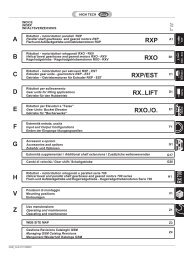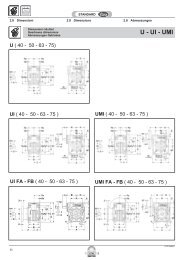AR/2-3 - STM POLSKA
AR/2-3 - STM POLSKA
AR/2-3 - STM POLSKA
You also want an ePaper? Increase the reach of your titles
YUMPU automatically turns print PDFs into web optimized ePapers that Google loves.
Quando la trasmissione del moto avviene<br />
tramite meccanismi che generano carichi<br />
radiali sull’estremità dell’albero,è necessario<br />
verificare che i valori risultanti non<br />
eccedono quelli indicati nelle tabelle.<br />
Nella Tab. 2.3 sono riportati i valori dei carichi<br />
radiali ammissibili per l’albero veloce (Fr1).<br />
Come carico assiale ammissibile contemporaneo<br />
si ha:<br />
Fa1 = 0.2 x Fr1<br />
Tab. 2.3<br />
In Tab. 2.4 sono riportati i valori dei carichi<br />
radiali ammissibili per l’albero lento (Fr2) .<br />
Come carico assiale ammissibile contemporaneo<br />
si ha:<br />
Fa2 = 0.2 x Fr2<br />
HIGH TECH line<br />
2.5 Carichi radiali e assiali 2.5 Axial and overhung loads 2.5 Radiale und Axiale<br />
Belastungen<br />
18<br />
<strong>AR</strong>/1<br />
<strong>AR</strong>/2<br />
<strong>AR</strong>/3<br />
<strong>AR</strong>/1<br />
n1<br />
min -1<br />
n1<br />
min -1<br />
Should transmission movement determine<br />
radial loads on the angular shaft end, it is<br />
necessary to make sure that resulting<br />
values do not exceed the ones indicated in<br />
the tables.<br />
In Table 2.3 permissible radial load for<br />
input shaft are listed (Fr1). Contemporary<br />
permissible axial load is given by the<br />
following formula:<br />
Fa1 =0.2xFr1<br />
In Table 2.4 permissible radial loads for<br />
output shaft are listed (Fr2). Permissible<br />
axial load is given by the following formula:<br />
Fa2 =0.2xFr2<br />
Fr1 (N)<br />
Fr1 (N)<br />
Wird das Wellenende auch durch Radialkräfte<br />
belastet, so muß sichergestellt werden,<br />
daß die resultierenden Werte die in<br />
der Tabelle angegebenen nicht überschreiten.<br />
In Tabelle 2.3 sind die Werte der zulässigen<br />
Radialbelastungen für die Antriebswelle<br />
(Fr1) angegeben. Die Axialbelastung<br />
beträgt dann:<br />
Fa1 =0.2xFr1<br />
<strong>AR</strong>../1<br />
32 40 50 60 80 100<br />
2800 170 320 430 520 600 1000<br />
1400 220 400 550 700 800 1200<br />
900 250 450 600 800 920 1300<br />
500 300 500 850 1100 1300 1500<br />
<strong>AR</strong><br />
25 32 40 50 60 80 100 120<br />
2800 —- 170 320 430 520 600 1000 1250<br />
1400 —- 220 400 550 700 800 1200 1500<br />
900 —- 250 450 600 800 920 1300 1600<br />
500 —- 300 500 850 1100 1300 1500 1800<br />
Tab. 2.4<br />
n2<br />
min -1<br />
Fr2 (N)<br />
In Tabelle 2.4 sind die Werte der zulässigen<br />
Radialbelastungen für die Abtriebswelle (Fr2)<br />
angegeben. Als zulässige Axialbelastung<br />
gilt:<br />
Fa2 =0.2xFr2<br />
<strong>AR</strong>-AM-AC<br />
32 40 50 60 80 100<br />
2400 - 600 1250 1350 1900 2500<br />
1850 - 650 1250 1450 2100 2800<br />
1250 530 700 1500 1650 2450 3000<br />
1100 570 720 1500 2000 2450 3500<br />
830 630 750 1500 2300 2600 3600<br />
630 700 850 1800 2400 2900 3700<br />
500 700 950 2000 2600 3400 3800<br />
400 740 1000 2200 2900 3800 3900<br />
300 880 1150 2300 3000 4200 4200<br />
250 970 1250 2500 3400 4500 4500<br />
200 1020 1370 2500 3800 5000 5500<br />
160 1070 1500 2500 3800 5500 6500<br />
130 1200 1500 2500 3800 6000 7500<br />
100 1260 1500 2500 3800 6000 8500<br />
80 1320 1500 2500 3800 6000 8500<br />
>70 1420 1500 2500 3800 6000 8500<br />
CT17IGBD0





